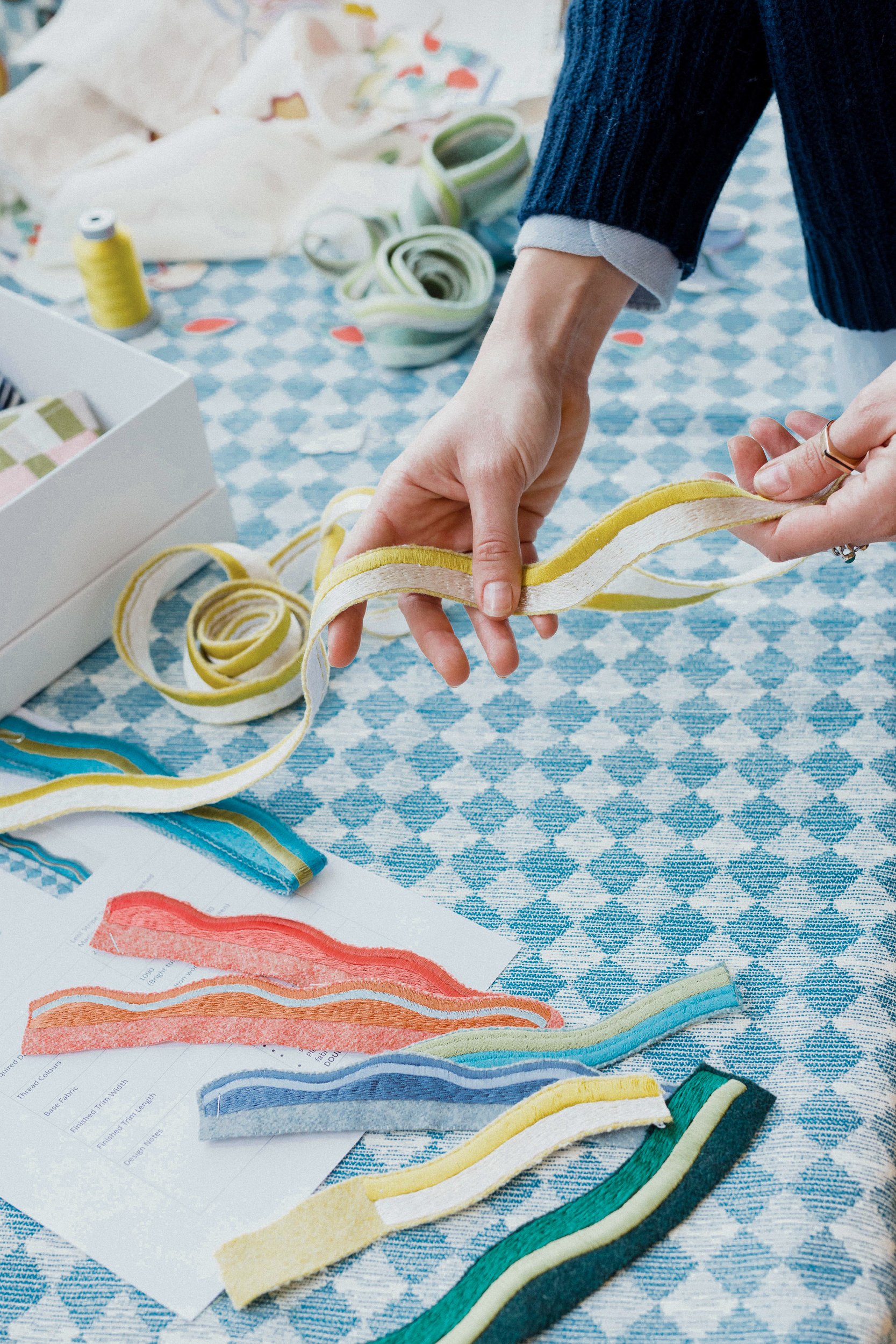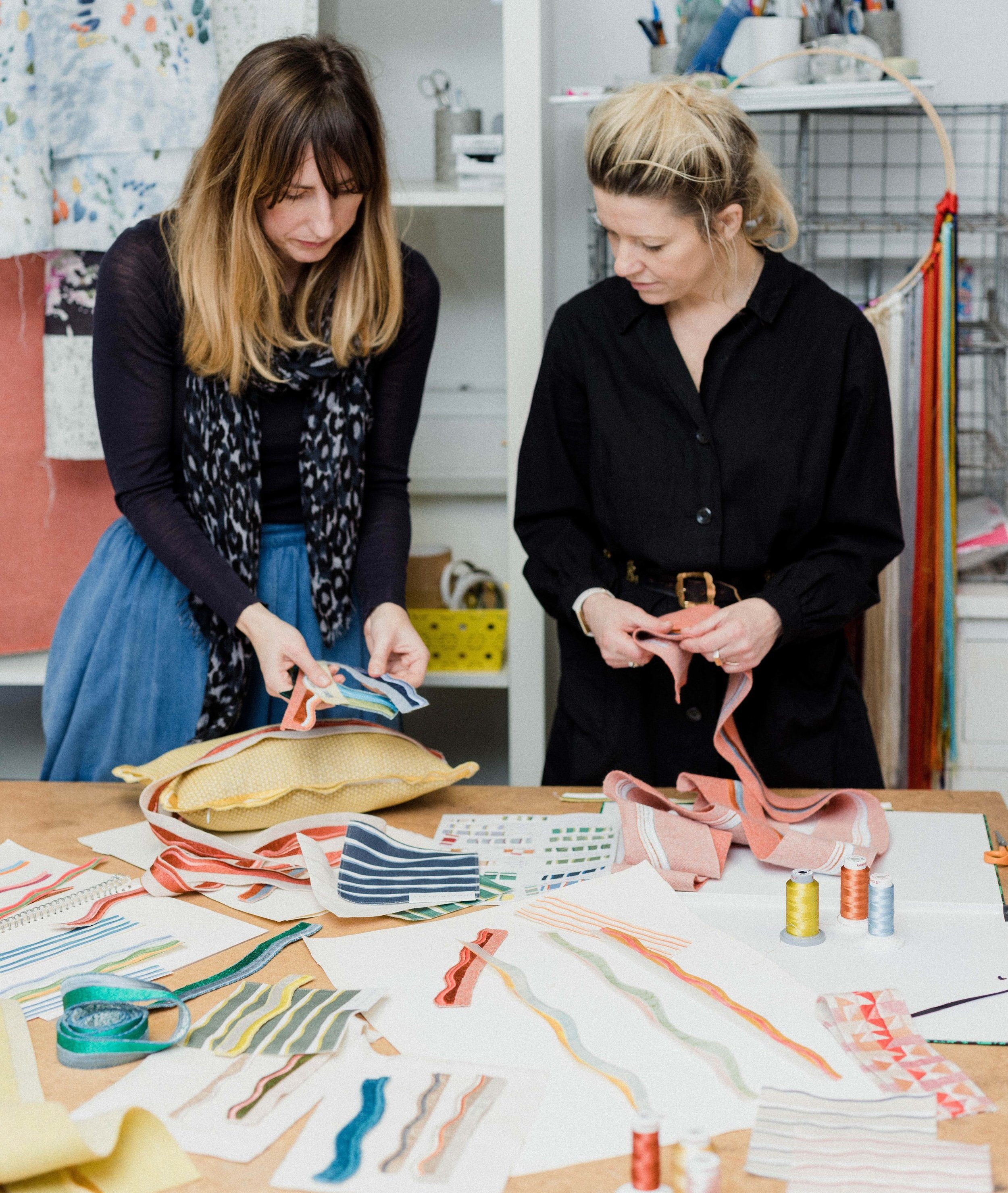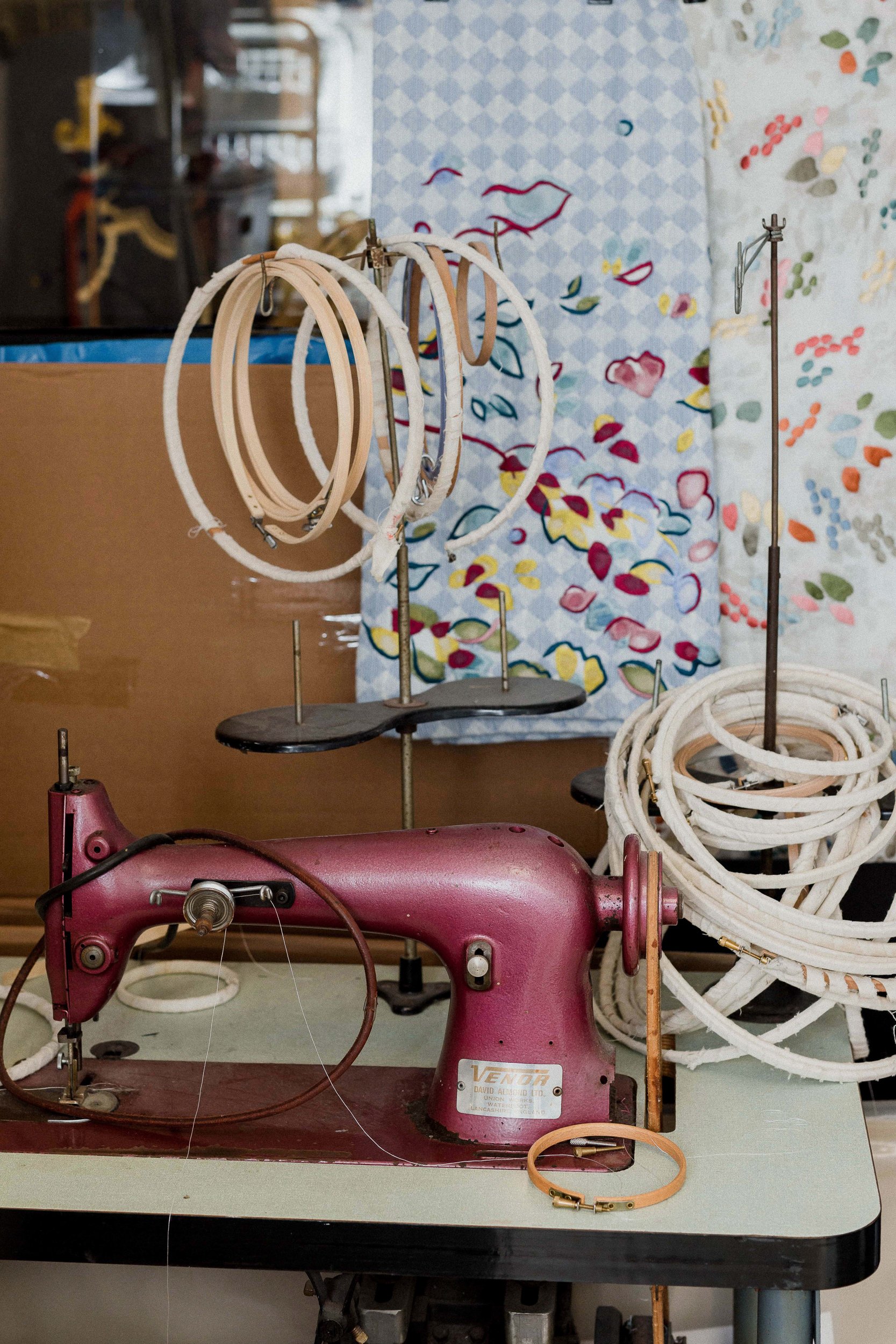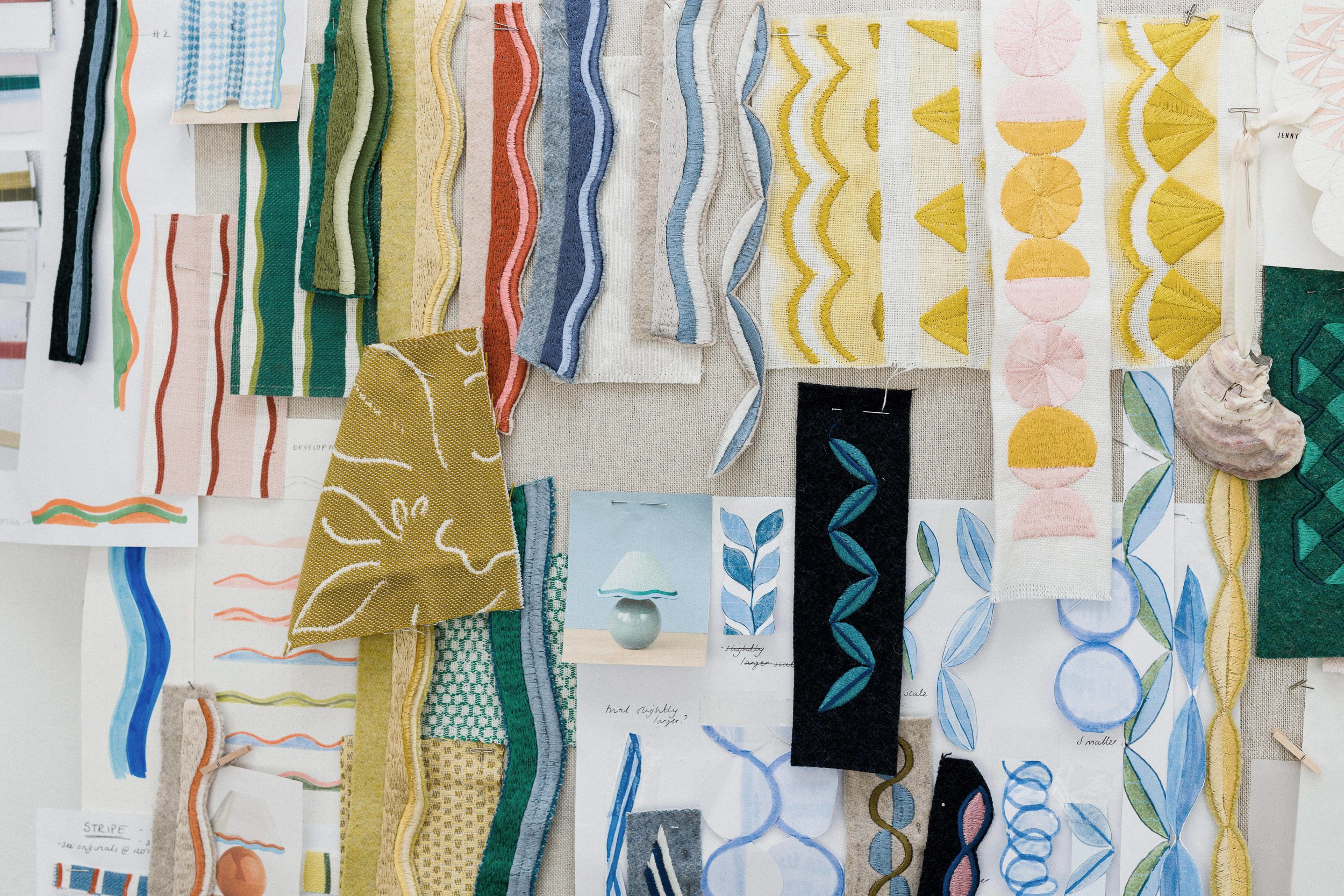Behind The Curtain | Celebrating the art of contemporary passementerie
Imogen Heath brings her signature sense of colour and pattern to handcrafted embroidered fabrics and trims. Collaborating with British embroidery studio Jenny King Embroidery, Heath champions the craftsmanship and art of passementerie and shows us a glimpse into how the two designers are using traditional techniques and processes to bring contemporary embroidery design to interiors.
From an unassuming modernist office building on the edges of Brighton’s creative quarter, pattern, colour, and texture fill the studios of Imogen Heath and Jenny King. Imogen creates beautiful textiles and wall coverings for the home with a focus on British manufacturing, while Jenny and her team create rich, luxurious embroidery for fashion's elite. As two designers who share a deep appreciation and admiration for craftsmanship, it is only natural that a collaboration would emerge. The outcome of their partnership is a contemporary collection of handmade interior passementerie that offers a fresh approach to traditional interior finishes.
Imogen Heath (left) Jenny King (Right)
Jenny King’s Brighton based embroidery studio
Imogen's collaboration with Jenny over the past three years has resulted in exclusive collections of embroidered fabrics and handmade passementerie. Sketches and designs are exchanged between the two studios, allowing Jenny and her team to bring Imogen's ideas to life through intricate stitching. This transforms printed textiles into luxurious, embellished lengths of cloth, as well as coveted, jewel-like embroidered trims and borders.
“I began to look more closely at the availability of colourful embroidered boarders, and I couldn’t see anything like the embroideries we were already creating, particularly passementerie that could work with our existing fabric collections. It seemed like an exciting and obvious idea to start creating our own passementerie collections.”
Handmade passementerie, a timeless decorative technique used for centuries, adds beauty and elegance to textiles, furniture, and interiors. Its intricate and delicate nature requires a high level of skill and craftsmanship, producing stunning results. Whether used to adorn curtains, upholstery, or lampshades, handmade passementerie is sure to add a touch of luxury to any space, whilst also contributing to a cohesive design scheme.
“Trims and borders are a wonderful way to elevate a scheme through the layering of tactile and luxurious qualities. Window treatments and cushions can be transformed to heirloom pieces by adding trim to a leading edge. Coordinate with plain linens for simpler schemes, or compliment patterned fabrics for more maximalist interiors.”
The term "passementerie" has its roots in the French language, stemming from "passement," which refers to silver or gold lace or braid, and "parchmentry," the practice of wrapping parchment in silk. In the 16th century, the word "passementerie" gained widespread use as these communities brought with them their expertise in the craft. By the 18th century, passementerie had become a thriving industry and is still commonly used in the fashion, clothing, and interiors sectors and are currently experiencing a new surge of interest. Imogen's modern approach to passementerie and collaboration with Jenny King, brings an exciting revival to this waning art form.
Starting life in Heath's studio as a series of sketches, each of the embroidery and passementerie designs are informed by the prints, colours and motifs present in Heaths fabric and wallpaper collections. Each design comes to life through a process of exploring different colours, shapes, and forms, and by experimenting with various combinations, the aim is to discover innovative ways to incorporate fresh new colour schemes and patterns into every area of the home. Offering an embroidery collection that transforms textiles into cherished heirlooms that will be passed down and appreciated for generations to come.
“All of the colours and the designs we create in our passementerie are unique to us as they echo existing motifs & colours already used in our fabric collections.”
The embroidery stitching techniques used in the collection bring the bold lines and abstract floral motifs of Imogen’s work to life. By using a range of colours and shapes that create a rich textural landscape across European and Irish linens, as well as recycled wool from the Scottish Isles. The embroidery designs seen in the collection often incorporate fabrics that play a key role in the Imogen Heath ranges, with remnants and offcuts of signature prints reworked into gestural appliqué designs. These are then layered onto printed or jacquard-woven fabrics, resulting in sumptuous and tactile surfaces.
Interpreting Heath's lines and shapes into beautiful stitch is the work of Jenny King and her team. Well-known in the fashion industry, Jenny King champions the use of traditional machinery and techniques to create embroidery for the likes of Erdem, Vivienne Westwood, and J.W. Anderson.
Keeping the art of Irish embroidery alive, Jenny and her studio team are adept in the art of machine embroidery using the ‘Irish’ Machine. Developed to mimic the skill and detail in hand embroidery, the Irish Machine creates detailed stitch work, drawing across the surface of fabric at high speed to create a desired embroidery design.
When it comes to fabricating Imogen's designs, the hand-drawn embroidery stitch perfectly compliments the illustrative and painterly qualities of her work, producing a tactile finish that elevates the design from the surface of the cloth.
To create the embroidery, the design must first be hand-drawn and then traced onto a delicate film. This film is then transferred and affixed onto the fabric, serving as a guide for the artisan to follow while stitching. After transferring the design onto the fabric, it is stretched over an embroidery hoop and positioned beneath the needle of the machine.
The art of embroidery involves manually guiding the fabric under the machine using a "Free hand" technique, while simultaneously controlling the size of the satin stitch with a knee pedal. This process is akin to playing a musical instrument and cannot be replicated by standard digital embroidery machines. As the embroiderer moves the embroidery hoop and fabric, the Irish machine, threaded with silken viscose thread, punctures the fabric's surface and transfers the design into the cloth. The process requires the artisan to work at high speed while maintaining consistency in the design and quality of the finished product, expertly manipulating the fabric and stitch. The design gradually emerges as various thread colours and stitch patterns are applied. The process is something quite mesmerising.
Using the same process, embroidered textiles and passementerie collections are created. For Imogen’s embroidered passementerie trims and borders, a repeat pattern is produced across pieced lengths of printed linen, or on top of beautiful, 100% recycled wool, which is woven in the Scottish Isles. Shapes are stitched in tandem to create repeating geometric patterns; or as seen in Heath’s newest embroidered trim collection, undulating waves, which take inspiration from the Leni Stripe printed linens seen within the collection.
Once stitched, each border or appliqué is hand-finished, either by turning and stitching the edges or by hand trimming the melton wool appliqués, ensuring the highest care is paid, and an exacting finish is achieved. Each trim is finished in-house before they are sent out to their new homes to be applied to cushions or drapes, or used to add embellishment to upholstery pieces.
The embroidered fabric collections, see lengths of Heath’s printed cloth transformed into artworks of their own. With large areas of embroidery traveling across the surface of the fabric, embellishing the print design with stitch. Imogen is keen to also think of ways to incorporate fabric waste and remnants into the embroidery collections. Textiles which are offcuts from the manufacturing process are incorporated into the embroidery designs by appliquéing cut out sections of the design to create new designs.
For example, our Abigail print is used as a degradé appliqué, building up the floral motifs used in the design, and stitching them down to a base cloth. In this instance our Emmy Lou check. The remnants of printed fabric are transformed into an informal botanical design that travels over the surface of the cloth, embellished with embroidered stitch.
Each embroidery design can be created to the bespoke requirements of the client, working to engineer the embroidery placement, for example; as the backs of chairs, drapes, or embroidered artwork panels for the walls. Imogen’s team provide their advice and knowledge to help clients introduce embroidery into their designs, homes and spaces, through a personalised consultation service.
The art of passementerie and embroidery is being preserved by modern artists and makers who are working with similar techniques and skills to create contemporary interpretations of traditional interior adornments.
“I feel it is my role as a British textile brand to creatively explore ways to celebrate and develop British textile craft and manufacturing, and … I feel a great responsibility to place this at the heart of what we do.”
As Imogen and Jenny continue to work together, the art of passementerie is being upheld as the two designers champion British craftsmanship. Bringing a contemporary sensibility and fresh approach to interior trims, borders and embroidery, Imogen’s collections breathe new life and excitement into an area of interior finishings that are rooted in a more traditional approach to design.
“Bringing a creative and contemporary edge to traditional crafts is what I believe we are best at as a brand, and I feel there is a lot of room to make passementerie more exciting… I have lots of ideas for the future.”
Article Credits
Photography – Jo Thorne Photography | jothornephotography.com | @jothornephotography
Collaborators – Jenny King Embroidery | jennykingembroidery.com | @jennykingembroidery


























